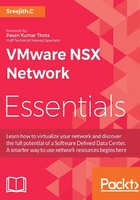
Introducing network planes
In a traditional switch/router, routing and packet forwarding is ideally done on the same device. What does this mean? Let's take a classic example of configuring a router. We might configure SSH for managing the router and later configure routing protocols to exchange the routes with its neighbors. All these common tasks are done specifically on the same hardware device. So, in a nutshell, each and every router will take a forwarding decision based on the configuration of routers. The power of software-defined networking is decoupling the forwarding and control plane functionality to a centralized device called a controller and the end result is the controller maintaining the forwarding information and taking decisions rather than going via hop by hop in the traditional way. As shown in the following figure, the three functional planes of a network are the management plane, the control plane, and the data plane:

The three functional planes of a network are explained as follows:
- Management plane: The management plane is a straightforward concept: a slice of software through which we will make changes and configure network devices, and protocols such as SSH and SNMP are used to access and monitor them.
- Control plane: The classic example for the control plane is learning routes and making decisions based on routing algorithms. However, control plane functionality is not limited to learning routes. The control plane also helps in pairing with vendor-specific devices, and secures control plane access such as SSH and Telnet.
- Data plane: Data plane traffic is traditionally performed in dedicated hardware devices by consuming a little bit of compute resources. Primarily, the data plane is focused on data forwarding tasks.
I know most of us will be wondering why we are discussing network planes here. Network planes are DNA in the NSX world and we have all three planes which make the network virtualization layer.